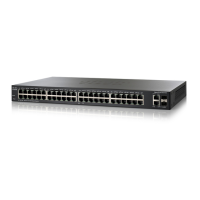Configuring Discovery
Configuring LLDP
Cisco Small Business 200 1.1 Series Smart Switch Administration Guide 61
7
STEP 4 To define a new policy, click Add and the
Add LLDP MED Network Policy
page
opens.
STEP 5 Enter the values.
• Network Policy Number—Select the number of the policy to be created.
• Application—Select the type of application (type of traffic) for which the
network policy is being defined:
• VLAN ID—Enter the VLAN ID to which the traffic should be sent.
• VLAN Tag—Select whether the traffic is Tagged or Untagged.
• User Priority—Select the traffic priority applied to traffic defined by this
network policy. This is the CoS value.
• DSCP Value—Select the DSCP value to associate with application data
sent by neighbors. This informs them how they should mark the application
traffic they send to the switch.
STEP 6 Click Apply. The network policy is defined.
NOTE You must manually configure the interfaces to include the desired
manually defined network policies for the outgoing LLDP packets using the
LLDP MED Port Settings.
Configuring LLDP MED Port Settings
The LLDP MED Port Settings page enables the selection of the LLDP-MED TLVs
and/or the network policies to be included in the outgoing LLDP advertisement for
the desired interfaces. Network Policies are configured using the LLDP MED
Network Policy page.
NOTE If LLDP-MED Network Policy for Voice Application (LLDP-MED Network Policy
Page) is Auto and Auto Voice VLAN is in operation, then the switch will automatically
generate an LLDP-MED Network Policy for Voice Application for all the ports that
are LLDP-MED enabled and are members of the voice VLAN.

